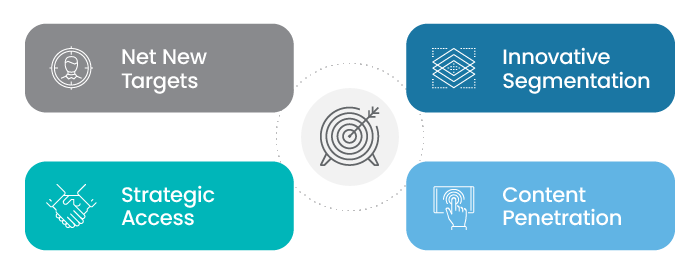Blog
3 Biopharmas Turning HCP Insights Into Field Action
Dec 09, 2024 | Brian Mahoney
Dec 09, 2024 | Brian Mahoney
The analytics team at a top 10 biopharma recently shared a new insight with sales colleagues: The industry was accessing target healthcare professionals (HCPs) its reps weren’t reaching. The field team was motivated: How were other brands reaching HCPs that they were not? And how could they change it?
Using analytics consulting powered by Veeva Pulse Field Trends data, the analytics team determined they were missing out on multi-channel engagement opportunities that could have given them a way to engage the HCPs they were missing. Equally important, this approach encouraged reps to use digital tools and field data to measure how effectively they were serving HCPs and their patients.
With 45% of HCPs accessible to biopharmas, field teams must optimize time with essential customers and accounts.

The following use cases show how three top 20 biopharmas use connected data and integrated analytics to empower field teams while coaching them on the best ways to apply insights.
1. Benchmark by therapeutic area to improve HCP engagement
Challenge: The company’s therapies span cardiovascular, neuroscience, oncology, and other areas. The breadth and depth of its offerings also reflect wide-ranging HCP access levels. For example, the director of customer engagement effectiveness says field reps in oncology typically have the most difficulty reaching target HCPs, especially the full customer universe.
When senior leadership asked the analytics team, “What does good field execution look like by therapeutic area, and where can we find opportunities to improve?” he says, “We looked outward because this wasn’t information we could find in-house.”
Solution: The biopharma uses analytics — combining patient, HCP, and payer data — to improve reach and coverage by therapeutic area. The team adds HCP engagement data to enhance customer engagement effectiveness and drive change management with the field force. The director says sharing data about competitors’ ability to reach HCPs they couldn’t access was motivational because his team “didn’t just show up with national benchmarks.” He says, “We applied data at a granular level for the field. We explained: ‘We understand these are hard-to-reach HCPs, but the data suggests we should be able to reach them, and here’s how we’re going to do it.’”
For example, using field trends data, the team identified two critical subsets of HCPs:
- Opportunity to engage: HCPs reached with high industry pressure but not reached by its reps in the last 12 months
- No-see: HCPs not reached by the company or the industry
“We identified what access looks like at an industry level and for specific therapeutic areas and created benchmarks and goals,” he says. The result was an action plan to surface ‘opportunity to engage’ HCPs and conserve limited resources by de-prioritizing others formerly on the target list. Using the engagement data, the team also worked with marketing to expedite a non-personal promotion strategy to engage ‘no-see’ HCPs.
2. Optimize rep efficiency and drive commercial success with segmentation
Challenge: The team at another top 10 biopharma sought to analyze sales rep interactions with target HCPs and benchmark their performance against other leaders in the neuroscience field. The team had pinpointed a critical segment of high-potential HCPs receptive to competitor reps but whom its reps were not reaching.
The associate director of advanced analytics for neuroscience, infectious disease, and vaccines, says, “The field is a significant investment; it’s human power that energizes the business overall, so we spend a lot of time considering data sources that enhance customer engagement.”
Solution: Using segmentation and targeting driven by Pulse data and its own prescriber information to segment the target audience into six distinct categories, the company identified the blockers for its neuroscience reps. The associate director explains that the analytics also helped establish meaningful, organization-wide benchmarks across therapeutic areas and answered questions like:
- Is physical access a barrier for just one or multiple therapeutic areas?
- Do opportunities exist to engage with different types of HCPs?
- Does the company have exclusivity with specific customers, and is that what we want?
The segmentation initiative yielded actionable insights that helped improve reps’ efficiency. Each segment came with specific action plans, enabling reps to prioritize high-prescribing, accessible HCPs while removing low-prescribing and inaccessible targets from their workload. The data-driven approach focuses efforts where they matter most, propelling the brand toward continued commercial success.
3. Empower teams to leverage advanced analytics
Challenge: The third company, a top 20 biopharma, is an early adopter of Veeva analytics and began using it to understand how physicians preferred to engage during COVID-19. More recently, the data team noted that reps weren’t accessing select essential HCPs and accounts with the same frequency as competitors in the ulcerative colitis and Crohn’s disease markets.
The vice president of business insights, development, and marketing says the team kicked off an initiative to benchmark field position according to multiple factors. One finding: the field force lagged in CLM usage. The lack of interactive visual aids during meetings may have negatively affected their ability to personalize content for HCPs.
Solution: The company has begun to flag and surface under-engaged HCPs to the field force to increase engagement. To help reps improve their interactions with physicians, the vice president of business insights and her team worked to improve CLM use, allowing reps to create approved content quickly. Finally, the team used field trends data within a business case, presenting it to the field team as an example of optimal ways to serve customers.
